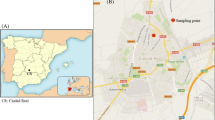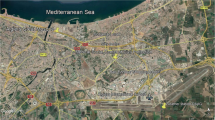Abstract
Traffic emits particles under 1 μm. The particles arethe most responsible to particle-bound polycyclic aromatichydrocarbon (pPAH) which can impact human health. To assessthem as health hazards, we monitored diurnal changes in theconcentration and distribution of pPAH near roads in Tokyo.The total pPAH concentration was determined using aphotoelectric aerosol sensor (PAS) which ionized PAH-adsorbingparticles. The total pPAH concentration was compared withchemical analyses by gas chromatography/mass spectrometry(GC/MS). Two sampling sessions, one in August and one inSeptember 2000, were done at three sampling sites at the Hongo Campus of the University of Tokyo. Monitoring was every two minutes for six consecutive days for the first session and for seven consecutive days for the second session.Correlation of the pPAH concentration with traffic flow andwith meteorological conditions were also assessed. The pPAHconcentration varied in the same manner on all days: it sharplyincreased in the early morning by a sudden burden of traffic, and it rapidly decreased during the daytime, probably owing tophotodegradation and/or dilution by rising in the mixingzone. The local wind field, and consequently thetransportation of pPAH from the road, were stronglyinfluenced by the configuration and location of thesurrounding buildings. The pPAH clearly changed in 1- and0.5 day cycles, particularly at the roadside.
Similar content being viewed by others
References
Agnesod, G., De Maria, R., Fontana, M. and Zublena, M.: 1996, ‘Determination of PAH in airborne particulate: Comparison between off-line sampling techniques and an automatic analyzer based on a photoelectric aerosol sensor’, Sci. Total Environ. 189/190, 443–449.
Beak, S. O., Field, R. A. and Goldstone, M. E.: 1991, ‘A review of atmospheric polycyclic aromatic hydrocarbons: Source, fate, and behavior’, Water, Air, and Soil Pollut. 60(3–4), 279–300.
Berkowicz, R., Palmgren, F., Hertel, O. and Vignati, E.: 1996, ‘Using measurements of air pollution in streets for evaluation urban air quality-meteorological analysis and model calculations’, Sci. Total Environ. 189/190, 259–265.
Caricchia, A. M., Chiavarini, S. and Pezza, M.: 1999, ‘Polycyclic aromatic hydrocarbons in the urban atmospheric particulate matter in the City of Naples (Italy)’, Atmosph. Environ. 33, 3731–3738.
Fan, Z., Chen, D., Birla, P. and Kamens, R. M.: 1995, ‘Modeling of nitro-polycyclic aromatic hydrocarbon formation and decay in the atmospheric’, Atmosph. Environ. 29, 1171–1181.
Junker, M., Kasper, M., Roosli, M., Camenzind, M., Kunzli, N., Monn, Ch., Theis, G. and Braun-Fahrlander, Ch.: 2000, ‘Airborne particle number profiles, particle mass distributions and particle-bound PAH concentrations within the city environment of Basel’, Atmosph. Environ. 34, 3171–3181.
Kamens, R. M., Guo, Z., Fulcher, J. N. and Bell, D. A.: 1988, ‘Influence of humidity, sunlight, temperature on the daytime decay of polyaromatic hydrocarbons on atmospheric soot particles’, Environ. Sci. Technol. 22, 103–108.
Kaupp, H. and McLachlan, M. S.: 1999, ‘Atmospheric particle size distribution of polychlorinated dibenzo-p-dioxins and dibenzofurans (PCDD/Fs) and polycyclic aromatic hydrocarbons (PAHs) and their implications for wet and dry deposition’, Atmosph. Environ. 33, 85–95.
Siegmann, K. and Siegmann, H. C.: 1998, ‘Molecular precursor of soot and quantification of the associated health risk’, in Current Problems in Condensed Matter, Plenum Press, New York, pp. 143–160.
Author information
Authors and Affiliations
Rights and permissions
About this article
Cite this article
Chetwittayachan, T., Kido, R., Shimazaki, D. et al. Diurnal Profile of Particle-bound Polycyclic Aromatic Hydrocarbon (pPAH) Concentration in Urban Environment in Tokyo Metropolitan Area. Water, Air, & Soil Pollution: Focus 2, 203–227 (2002). https://doi.org/10.1023/A:1021331217488
Issue Date:
DOI: https://doi.org/10.1023/A:1021331217488




